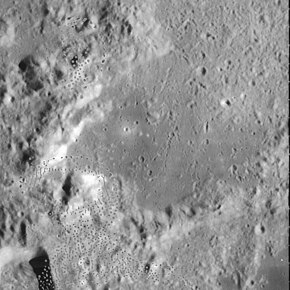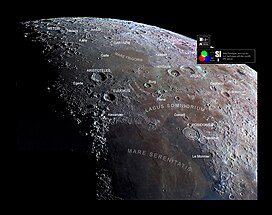 Lunar Orbiter 4 image Lunar Orbiter 4 image(spots are blemishes on original image) | |
| Coordinates | 40°18′N 13°30′E / 40.3°N 13.5°E / 40.3; 13.5 |
|---|---|
| Diameter | 95 km |
| Depth | 410 m |
| Colongitude | 347° at sunrise |
| Eponym | Alexander the Great |

Alexander is a lunar impact crater-like feature in the rugged surface to the north of Mare Serenitatis. It lies to the south-southwest of the prominent crater Eudoxus, and to the east-northeast of Calippus. It was named after Alexander the Great.

The Alexander formation has been so heavily worn and distorted with the passage of time that it now resembles little more than a lowland region enclosed by rugged ranges. The rim segments lie along the northwest, west, and south sections of the crater, while the eastern side stands open to the surrounding surface. The surviving walls are nearly rectangular in form, with the most prominent mounts in the northwest.
The crater floor is more smooth and has a darker albedo in the western half, and gradually grows lighter and more impacted toward the east. There are no craters of significance within the perimeter of this formation, although there are tiny craterlets aplenty in the rougher eastern section.
Satellite craters
By convention these features are identified on lunar maps by placing the letter on the side of the crater midpoint that is closest to Alexander.
| Alexander | Latitude | Longitude | Diameter |
|---|---|---|---|
| A | 40.7° N | 14.9° E | 4 km |
| B | 40.3° N | 15.2° E | 4 km |
| C | 38.5° N | 14.9° E | 5 km |
| K | 40.5° N | 19.3° E | 4 km |
References
- Westfall, John E. (2000). Atlas of the Lunar Terminator. doi:10.1017/CBO9780511525162. ISBN 9780521590020.
- "Alexander". Gazetteer of Planetary Nomenclature. USGS Astrogeology Research Program.
- Andersson, L. E.; Whitaker, E. A. (1982). NASA Catalogue of Lunar Nomenclature. NASA RP-1097.
- Bussey, B.; Spudis, P. (2004). The Clementine Atlas of the Moon. New York: Cambridge University Press. ISBN 978-0-521-81528-4.
- Cocks, Elijah E.; Cocks, Josiah C. (1995). Who's Who on the Moon: A Biographical Dictionary of Lunar Nomenclature. Tudor Publishers. ISBN 978-0-936389-27-1.
- McDowell, Jonathan (July 15, 2007). "Lunar Nomenclature". Jonathan's Space Report. Retrieved 2007-10-24.
- Menzel, D. H.; Minnaert, M.; Levin, B.; Dollfus, A.; Bell, B. (1971). "Report on Lunar Nomenclature by the Working Group of Commission 17 of the IAU". Space Science Reviews. 12 (2): 136–186. Bibcode:1971SSRv...12..136M. doi:10.1007/BF00171763. S2CID 122125855.
- Moore, Patrick (2001). On the Moon. Sterling Publishing Co. ISBN 978-0-304-35469-6.
- Price, Fred W. (1988). The Moon Observer's Handbook. Cambridge University Press. ISBN 978-0-521-33500-3.
- Rükl, Antonín (1990). Atlas of the Moon. Kalmbach Books. ISBN 978-0-913135-17-4.
- Webb, Rev. T. W. (1962). Celestial Objects for Common Telescopes (6th revised ed.). Dover. ISBN 978-0-486-20917-3.
- Whitaker, Ewen A. (1999). Mapping and Naming the Moon. Cambridge University Press. ISBN 978-0-521-62248-6.
- Wlasuk, Peter T. (2000). Observing the Moon. Springer. ISBN 978-1-85233-193-1.
